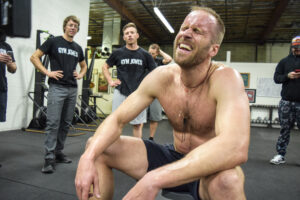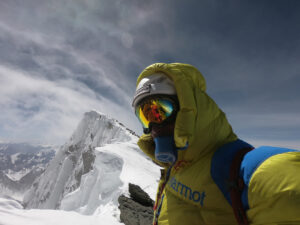By Fredrik Sträng
Image: Chuck Norris visiting a sandcastle he built as a child (AI-generated image)
Your experience and perspective on a situation are crucial—not just for how you view a task, but also for how you approach it. It’s a game-changer and sometimes the difference between success and failure. Navigating through tough challenges, such as completing a Swedish Classic, starting your own business, embarking on an education later in life, or taking the bold step to move abroad, not only builds character—it transforms your view of what’s possible. Suddenly, the boundary of what feels “impossible” shifts because your frame of reference for what’s long, hard, or demanding has fundamentally changed. In this article, I share my insights on how you can strengthen your resilience and take control of your life—with the power of new perspectives.
“What is normal for the spider is chaos for the fly.” – Morticia Addams
How a mountain became a speed bump
In the early 2000s, I lived in Gästrikland. Not a region directly associated with high mountains, so I had to settle for Kungsberget, or “Kings Mountain” as I call it; it sounds more impressive that way. 204 vertical meters from the base of the mountain to the top. There I toiled year in and year out with up to 30 kg in my backpack. Jogging up and jogging down. Sometimes with a straw in my mouth I imitate the thin air at 8000m peaks. All to peak my form for my progressively larger and larger expeditions involving higher and higher mountains. Those who took the lift had a favourite quip when they saw me struggling and huffing up the mountain, sunk in snow up to my knees. “Did you forget your lift ticket?” Witty, yes, but the height of irony was surely when I, in response to the question “Isn’t it hard?” laconically replied, “That’s the point!”
No pain, no gain. No pain, no progress. No pain, no victory. No pain, no triumph.
The magic occurred when I returned to Kungsberget after each expedition I completed to the giants in the Himalayas. In some fascinating way, Kungsberget seemed to get smaller and smaller every time I returned! Of course, no landscaper had cut off the top of Kungsberget or placed an earth mound around the base of the mountain to reduce its prominence. With the perspectives I brought from the roof of the world—Nepal—Kungsberget gradually transformed from a mountain to a speed bump.
My attitude towards Kungsberget hadn’t diminished. Nor had I become either arrogant or cocky from being able to call myself a Himalayan climber. The simplest explanation is that the skin on my nose had grown. My perception of the world, my preconceived notions, and the limitations I had imposed on myself had stretched, like a rubber band, without breaking. What my brain had interpreted as high, long, hard, and tough had been re-evaluated when I stretched my ability among the impressive 8000m peaks in the Far East. A more sensible question might have been, hadn’t I underestimated my capacity, now that I look back? I live by the motto “more prepared than the task requires, so you can handle any eventualities that arise.” This is not the theme of the article, but it is central to emphasize the importance of having overcapacity when engaging in a risky sport like mountaineering. Living on the edge of what you physically can manage means you can’t afford large margins of error, otherwise, you can get hurt, or worse, be left on the mountain. The lesson of how Kungsberget became a speed bump is twofold. On the one hand, it pays to be extra prepared for large goals so you can focus on things other than struggling and staring at your feet—you can lift your gaze and enjoy the journey towards the goal. On the other hand, we grow as individuals when we are challenged, when we are tested, and when we get to stretch our comfort zone. This makes us grow as individuals and whenever a difficult task arises, you can always say, “I’ve been through worse!”
The fall of the berlin wall: a perspective that changed the world
The fall of the Berlin Wall is one of the most symbolic events in modern history. For a long time, the wall was considered a given—a geographical and ideological barrier between East and West. But in the 1980s, people in East Germany began to question the wall as a part of life and see it for what it really was: a symbol of oppression. The changed perspective—from accepting the wall to seeing it as a barrier to freedom—became the driving force behind a peaceful revolution. When people began to understand that the wall did not have to be a permanent part of their lives, they gathered in the streets and protested.
On November 9, 1989, the Berlin Wall fell, marking not only the end of a physical barrier but also an old mindset. What can we learn from this when building resilience? The fall of the Berlin Wall reminds us that even the most ingrained obstacles can be overcome with a changed perspective. When we face difficulties, it might be a new way of thinking that helps us find solutions and ways forward. By challenging our own limitations and looking at problems from another angle, we can change both our own reality and the world around us. Sometimes, the changed perspective is the key to building both personal resilience and a new way forward.
Look more often in the rear-view mirror
Everything would be easier if people looked more often in the rear-view mirror! I don’t just mean that drivers would be safer on the roads, but if we were reminded of what we have done historically, we wouldn’t so easily throw out clichés like “it’s impossible,” “I don’t have time,” or “it’s impossible!”
Do you, like me, find it strenuous to drive at night in a snowstorm? And it doesn’t get easier when you turn on the headlights, because then you’re dazzled by snowflakes hitting the windshield, like a swarm of stars. If only it were as fun as travelling in hyperspace as they do in Star Wars! No, it’s straining for the eyes to drive during a snowstorm. It’s much more comfortable to sit in the back seat and look back. Then the “stars” disappear at a furious pace. It gives a relieving feeling as if worries are falling off you like water off a duck’s back. It’s meditative and brings calm.
Being a passenger and looking back during a snowstorm is the same feeling I get when facing a difficult task. I use the rear-view mirror and look away from the snowflakes, reminded of what I have achieved before. I am strengthened by the knowledge that I have a rich record of successes to lean on. I have done similar—and maybe more difficult—things before. Therefore, I should be able to handle this as well.
So, tell yourself, just like Pippi Longstocking: “I have never tried that before, so I think I should definitely be able to do that!” This line captures Pippi’s confident and curious attitude towards life and challenges and is one of her most iconic quotes. It reminds us to dare to try new things without fear of failure.
Lean confidently on your previous successes. Write them down on a list so that you remind yourself every time you have an exam, an important meeting, a competition, or a job interview. You have succeeded before—so you can surely handle this!
I go to the gym, but nothing happens.
You’ve decided to start working out at the gym. The first day you go there and look at yourself in the mirror afterwards. Nothing has happened. The second day you go again, look at yourself in the mirror—and still nothing. The third day you go there, and now you start to feel pain in your body, but the mirror still says nothing. On the fourth day, you have a hard time getting out of bed, and you might start doubting your decision to start working out. And so it continues until you reach the thirtieth day. Now, something has finally happened when you step on the scale. You start to see small changes in the mirror. You feel stronger than in a long time. You have gained better self-confidence and smile at yourself in the mirror—in a non-narcissistic way. “What an ordeal,” you think. But above all, you now know that Rome wasn’t built in a day. So why did you have such disproportionately high expectations of a total transformation in no time when you decided to start working out? Why were you so impatient? According to bupa.com, 80% of Britons give up their New Year’s resolutions after just two weeks!
Think about when you learned to ride a bike—did it happen immediately? When you learned to read, did you master it in fifteen minutes? When you learned to swim, were you a master in the water right away? No, the list goes on…
So many times, you have started over. So many times, you have been totally inept, downright incompetent. But you continued. You got your driver’s license, no matter how many times you stalled the car. You know that perfection takes time. So why be so impatient or insecure when it comes to other things in life?
Do you recognize yourself when you take on a brick-sized book, an 800-page monster, and think “Jesus, this is going to take time”? But then you read. And read. And after an hour you have gotten through 50 pages. If you continue reading an hour every day, you will be done in half a month. This is how I tackle my mountains. One step at a time. Because I know I will get there eventually. Zoom out, get a helicopter perspective, and understand that a little every day works wonders over time.
The apollo program and the moon landing
In 1961, President John F. Kennedy set a goal that at the time sounded almost unthinkable: to send a man to the moon and return him safely before the decade was out. It was a bold promise, a vision that went far beyond the technical and logistical possibilities that existed at the time. But it was precisely this shift in perspective—from asking “Can we do it?” to firmly focusing on “How do we do it?”—that made it possible to achieve the seemingly impossible.
Reaching the moon was not just an engineering feat. It was a lesson in resilience, both on an individual and collective level. NASA and its partners faced enormous hurdles. They had to invent entirely new technologies, develop methods for navigating space, and handle risks never encountered. Failure was never an option, but mistakes along the way were inevitable—and instructive. Every setback, from test failures to technical crises, was handled with the question: How do we move forward from here?
It wasn’t just the technology that changed during the Apollo program. The perspective on what was possible for humanity shifted. The iconic image of Earth as a blue marble, taken from the moon’s surface, gave us all a new way to see our place in the universe. It helped create a global awareness of our planet’s fragility and interconnectedness—and perhaps that’s why the moon landing still feels like a part of our shared heritage.
What can we learn from this in our own lives? When we face difficult challenges, whether it’s in our careers, health, or relationships, we can be inspired by the fundamental principle of the Apollo program: to shift focus from limitations to solutions. Changing the perspective from “Can I?” to “How can I?” can be the key to not just surviving difficulties but growing from them.
Just as the journey to the moon was about thinking beyond our technical limitations, we can build our own resilience by thinking beyond our fears and doubts. When we face setbacks, whether they feel like small steps or giant leaps, we can remind ourselves that perspective changes everything—and that we are capable of more than we think.
Concluding Words
Trolls burst in sunlight. Often, we paint unnecessary clouds of worry, and when we finally get a task done, we look back and think: Wasn’t it harder than this? Why did I worry so much unnecessarily? What a waste of time and energy! So, take a deep breath. Maybe step back and get some perspective before stressing over the new year. Has it worked out before? Yes, it has. Are you paralysed? No, probably not. Are you a talentless dork? No, I really hope not. And remember, Chuck Norris doesn’t need perspective. Perspective needs him!
Take a deep breath and look in the rear-view mirror. You got this!
——————-
About Fredrik Sträng: Fredrik, in his leadership role, has summited seven of the world’s fourteen 8,000-meter peaks, set a Guinness World Record, and lectures on leadership, communication, decision-making, and crisis management.
Best regards,
Fredrik Sträng
Climber – Speaker – Coach







